Author: Kevin Li Source: Artemis Translation: Shan Ouba, Golden Finance
Fundamental investors, we have done in-depth research on Strategy, CoreWeave, Coinbase, Circle, and Hyperliquid.
Ethereum has recently received renewed attention, especially after the rise of the narrative of "ETH as corporate treasury reserve". One of our fundamental analysts has built an ETH valuation framework and put forward a convincing long-term bull case. Feel free to contact us and exchange ideas - of course, don't forget to do your own research.
Next, please see analyst Kevin Li's in-depth analysis of ETH.
Executive Summary:
Ethereum (ETH) is transforming from a misunderstood asset to a scarce, programmable reserve asset, providing security and operating foundation for an on-chain ecosystem that is rapidly moving towards institutionalization.
ETH’s adaptive monetary policy projects a continued decline in inflation—even at 100% stake, annual inflation caps at ~1.52% and by year 100 (2125), this rate will drop to ~0.89%. This is not only significantly lower than the 6.36% average annual expansion of the US M2 money supply from 1998–2024, but is even comparable to the growth in gold supply.
Institutional adoption is accelerating, with giants such as JPMorgan Chase and BlackRock deploying businesses on Ethereum, which continues to drive structural demand for ETH for on-chain security and value settlement.
The annual correlation between on-chain asset growth and native ETH staking is as high as 88%+, highlighting the strong economic alignment.
The SEC’s clarification on staking policy on May 29, 2025 reduces regulatory uncertainty. The latest Ethereum ETF application has added staking provisions, further enhancing the potential for returns and institutional appeal.
ETH’s high composability makes it a productive asset: it is used for staking and re-staking, as DeFi collateral (such as Aave, Maker), automated market maker (AMM) liquidity (such as Uniswap), and is also the native gas token of many Layer 2 networks.
While Solana has attracted a lot of attention in the meme coin craze, Ethereum’s greater decentralization and security make it more dominant in the market for higher-value, long-term sustainable asset issuance.
With Sharplink Gaming ($SBET) pioneering the Ethereum treasury configuration in May 2025, the ETH fiscal reserve narrative has emerged, and more than 730,000 ETH are now held by public companies. This demand path mirrors the fiscal reserve wave of Bitcoin in 2020, driving ETH’s recent strong performance relative to BTC.
Not long ago, Bitcoin’s position as a “store of value” was questioned, and the “digital gold” argument sounded absurd to many. Today, Ethereum (ETH) is facing a similar identity crisis. It is often misunderstood, underperforming many of its competitors on an annualized basis, missing multiple meme cycles, and encountering bottlenecks in overall retail adoption in the crypto ecosystem.
ETH is often criticized for its lack of a clear value accumulation mechanism, and the rise of Layer 2 has cannibalized underlying fee income, thereby weakening ETH’s position as a monetary asset. When ETH is viewed as a single representation of "transaction fees," "protocol revenue," or "real economic value," it looks more like a cloud computing stock—closer to Amazon stock than a sovereign digital currency.
But in my opinion, this understanding is a misclassification of the asset type. Measuring ETH only from the perspective of cash flow or protocol revenue is to confuse completely different asset classes. The correct way is to understand it in the framework of "commodity-like assets," which is closer to the positioning of Bitcoin. More precisely, ETH is a unique asset class: a scarce, producible, programmable reserve asset, whose value accumulation comes from its core role in providing security, settlement, and computing power in the on-chain economy—and this on-chain economy is rapidly moving towards institutionalization and composition.
Why the world needs new options in an era of devaluation of fiat currencies
To truly understand the evolution of ETH's monetary attributes, it is necessary to put it into a larger macroeconomic context - especially in the current era of increasing fiat currency devaluation and monetary expansion. Driven by continuous government stimulus and spending, official inflation rates are often underestimated. Although CPI data generally show annual inflation of around 2%, this indicator is often modified, which may mask the true loss of actual purchasing power.
Between 1998 and 2024, the average annual inflation of the US CPI is 2.53%, while the M2 money supply expands at an average annual rate of 6.36% - which is not only far higher than the rate of inflation and house price increases, but even close to the average annual return of the S&P 500 (8.18%). This also means that most of the nominal growth in US stocks may be more the result of monetary expansion rather than productivity gains.
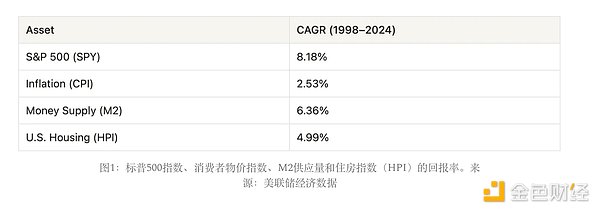
This surge in money supply reflects the government's increasing reliance on monetary stimulus and fiscal spending in the face of economic instability. For example, the Trump administration's Big Beautiful Bill (BBB) is an aggressive fiscal stimulus policy that is widely seen as inflation-oriented; while the "Department of Government Efficiency" (DOGE) policy, which was strongly advocated by Musk, has been far less effective than expected.
All of the above have exacerbated market concerns about the failure of the traditional monetary system, and further accelerated people's urgent need for a new generation of value storage tools or forms of currency.
What constitutes a "store of value"? Where does ETH fit in?
A reliable store of value generally needs to meet four criteria:
Durability: Ability to withstand the test of time without corrosion or degradation.
Value preservation: Ability to maintain purchasing power during different market cycles.
Liquidity: Must be able to be easily traded in active markets.
Adoption and Trust: It must be widely trusted or adopted.
At present, ETH performs well in durability and liquidity. Its durability comes from the decentralization and security of the Ethereum network; and its liquidity is very high - ETH is the second most traded crypto asset in the world, with a deep market in both centralized and decentralized exchanges.
However, if evaluated from the perspective of "value storage means" in the traditional sense, ETH is still controversial in terms of "value preservation ability", "adoption" and "trust". This is also where the concept of "scarce programmable reserve assets" is more in line with ETH's positioning - it emphasizes ETH's active role and unique mechanism in value maintenance and trust building.
ETH’s Monetary Policy: Scarce but Adaptable
One of the most controversial issues surrounding ETH’s ability to be a store of value is its monetary policy, specifically its design around supply and inflation. Critics often point out that Ethereum does not have a fixed maximum supply cap. However, this criticism overlooks the architectural complexity and subtlety of Ethereum’s dynamic issuance model.
ETH issuance is dynamically related to the amount of ETH staked. While issuance does increase with greater stake participation, this relationship is sublinear: that is, inflation increases more slowly than the amount staked. This is because issuance is inversely proportional to the square root of the total amount staked, creating a natural mitigation mechanism for inflation.
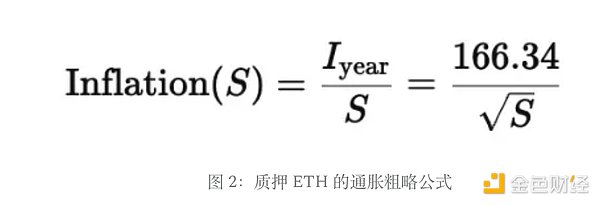
This mechanism establishes a gradually decreasing soft inflation cap, which will tend to slow down even if the stake participation rate continues to rise. In the most extreme scenario set by the model (i.e. 100% ETH is staked), the annual inflation rate is capped at about 1.52%.
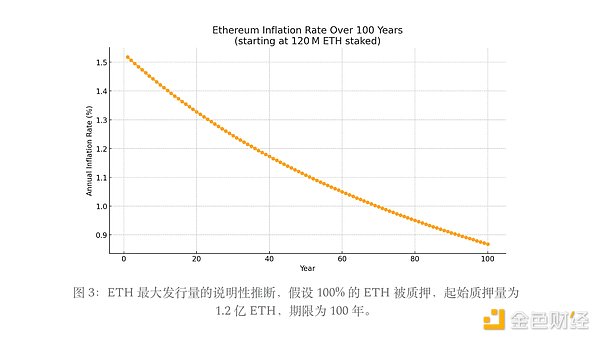
More importantly, even under this most conservative scenario, the inflation rate will continue to decline over time - following an exponential decay curve. Assuming 100% staking and no destruction mechanism, the inflation rate trend is as follows:
Year 1 (2025): About 1.52%
Year 20 (2045): About 1.33%
Year 50 (2075): About 1.13%
Year 100 (2125): About 0.89%
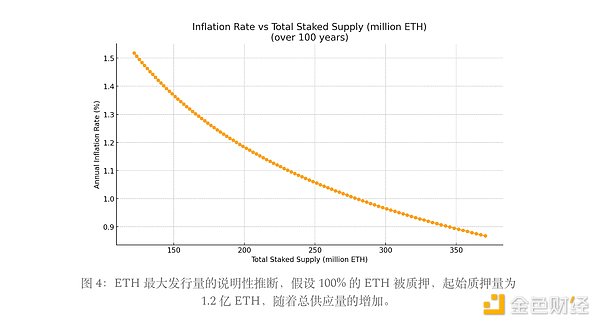
Even in this conservative scenario, Ethereum’s inflation rate is still trending downward, reflecting a kind of built-in monetary discipline, which strengthens its credibility as a long-term store of value.
And the situation improves further if the burn mechanism introduced by EIP-1559 is taken into account. This mechanism will permanently remove a portion of transaction fees from circulation, which means that ETH’s net inflation rate can be much lower than the total issuance rate, and even turn negative (i.e. deflation) in some periods. In fact, since Ethereum switched from proof-of-work (PoW) to proof-of-stake (PoS), ETH’s net inflation rate has always been lower than the issuance rate, and there have been deflationary phases from time to time.
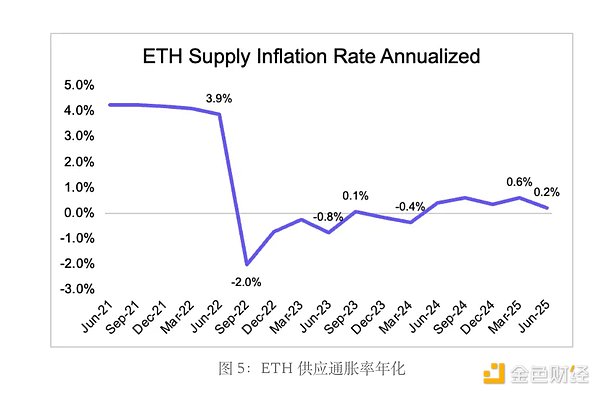
Compared to fiat currencies such as the US dollar - whose M2 money supply grows by more than 6% per year on average - Ethereum's structurally constrained (and even potentially deflationary) supply mechanism makes it more attractive as a value asset. Notably, Ethereum's maximum supply growth is now on par with or even lower than gold, further solidifying its position as a reliable monetary asset.
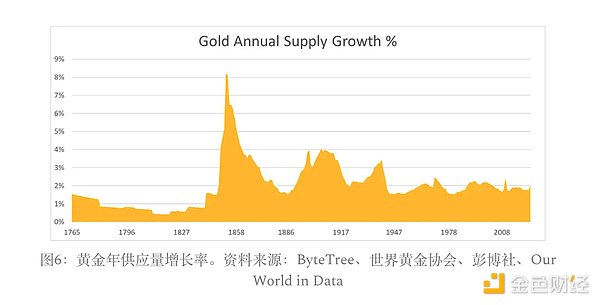
Institutional Adoption and Trust
While Ethereum’s monetary mechanism effectively solves the supply dynamics problem, its real-world utility as a settlement layer is now the core factor driving adoption and gaining institutional trust. Major financial institutions are building applications directly on Ethereum: Robinhood is developing a tokenized stock platform, JPMorgan is planning to launch its deposit token JPMD on Ethereum’s second-layer network Base, and BlackRock is tokenizing money market funds using BUIDL on the Ethereum network.
This trend towards on-chaining stems from a strong value proposition that can solve inefficiencies in traditional finance and unlock new opportunities:
Efficiency and Cost Reduction: Traditional finance relies on intermediaries, manual processes, and slow settlement mechanisms. Blockchain simplifies processes through automation and smart contracts, thereby significantly reducing costs, errors, and processing time from days to seconds.
Liquidity and Fractional Ownership: Asset tokenization allows illiquid assets such as real estate and art to be fractionalized, broadening investor participation channels and unlocking locked-up capital.
Transparency and Compliance: Blockchain’s immutable ledger ensures a verifiable audit trail, simplifying compliance processes and reducing fraud risks through real-time transaction and asset ownership visibility.
Innovation and Market Access: Composable on-chain assets have driven the birth of new financial products, such as automated lending or synthetic assets, creating new channels for income and expanding the coverage of financial services.
ETH Staking: Alignment of Security and Economic Interests
The on-chain migration of traditional financial assets highlights two core drivers of ETH demand. First, the growth of real-world assets (RWA) and stablecoins has increased on-chain activity, driving demand for ETH as a gas token. More importantly, as Tom Lee pointed out, institutions may need to purchase and stake ETH to secure the infrastructure they rely on, thereby aligning their interests with Ethereum's long-term security. In this context, stablecoins can be seen as Ethereum's "ChatGPT moment" - a major breakthrough application scenario that demonstrates the platform's transformative potential and wide range of uses.
As more and more value is settled on-chain, the alignment between Ethereum’s security and economic value becomes increasingly important. Its finality mechanism, Casper FFG, ensures that blocks are finalized only when at least two-thirds of the staked ETH reaches consensus. While an attacker controlling at least one-third of the staked ETH cannot finalize a malicious block, they can prevent finality by undermining the consensus mechanism. In this case, Ethereum can still propose and process blocks, but the lack of finality means that these transactions may be reversed or reordered, which poses a significant risk to institutional settlement use cases.
Even applications running on Layer 2 rely on the Ethereum mainchain for final settlement. Rather than undermining the value of ETH, Layer 2 strengthens ETH’s position by requiring security and gas from the main layer. They submit proofs to Ethereum, pay base fees, and often use ETH as the native gas token. As rollups scale, Ethereum’s role as a secure settlement layer accumulates value.
In the long term, many institutions may gradually shift from custodial passive staking to running their own validation nodes. Although third-party staking solutions are more convenient, operating a validation node gives institutions more control, higher security, and allows them to directly participate in the consensus process. This is especially important for stablecoin and RWA issuers, as they can use it to capture MEV, ensure reliable inclusion of transactions, and leverage private execution capabilities - all key capabilities to ensure operational stability and transaction integrity.
More importantly, wider institutional participation in validation node operations can help alleviate Ethereum's current high concentration of staking, which is currently concentrated in a few large players, such as liquid staking protocols and centralized exchanges. Institutional participation helps diversify validation nodes, enhance Ethereum's level of decentralization, and improve its anti-censorship and credibility as a global settlement network.
From 2020 to 2025, a persuasive trend further reinforces the logic of interest alignment: the growth of on-chain assets is highly synchronized with the growth of ETH staking. As of June 2025, the total supply of stablecoins on Ethereum reached $116.06 billion, and the tokenization scale of real-world assets (RWA) rose to $6.89 billion. At the same time, the total amount of staked ETH rose to 35.53 million, which significantly reflects that network participants are simultaneously strengthening security while expanding on-chain value.
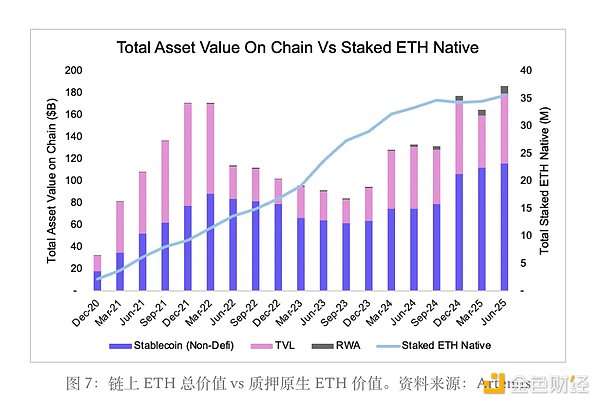
Across major asset classes, the annual correlation between on-chain asset growth and native ETH staking remains above 88%. In particular, there is a close correlation between stablecoin supply and ETH staking. Although quarterly correlations are greatly affected by short-term fluctuations, the long-term trend is clear - as assets migrate to the chain, the motivation to stake ETH also increases.
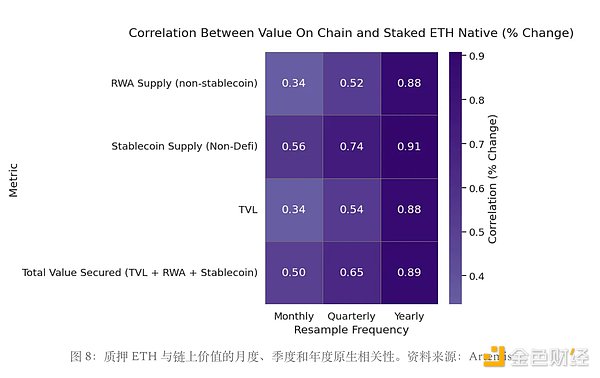
In addition, staking growth also directly affects ETH's price dynamics. As more ETH is staked and withdrawn from the circulation market, the circulating supply of ETH tightens during cycles of surging on-chain demand. Our analysis shows that the correlation between ETH stake and price is 90.9% on an annual scale and 49.6% on a quarterly scale. This further supports the view that staking not only ensures network security, but also creates positive supply and demand pressure on ETH prices in the long run. On May 29, 2025, the latest policy clarification issued by the U.S. Securities and Exchange Commission (SEC) Division of Corporation Finance eased the regulatory uncertainty surrounding Ethereum staking. The statement stated that under certain conditions, protocol-layer staking activities (such as self-staking, entrusted staking, or qualified custodial staking) do not constitute securities issuance. Although more complex staking arrangements still require individual judgment, this clarification has encouraged institutions to participate more actively.
After the announcement, Ethereum ETF applications filed began to include staking provisions, allowing funds to earn rewards while participating in the security of the network. This not only improves the return structure, but also further solidifies the trust foundation of Ethereum as a platform for long-term institutional adoption.
Composability and ETH as a productive asset
One of the key differences between ETH and pure value store assets such as gold and Bitcoin is its composability, which in itself can drive demand for ETH. Compared to non-productive assets such as gold and BTC, ETH is natively programmable and plays an active role in the Ethereum ecosystem, powering decentralized finance (DeFi), stablecoins, and Layer 2 networks.
Composability refers to the ability of protocols and assets to interoperate seamlessly. In Ethereum, this makes ETH not just a monetary asset, but also an important building block for on-chain applications. As more and more protocols are built around ETH or directly on ETH, the demand for ETH has increased - not just as gas, but also as collateral, a source of liquidity, and pledged capital.
Currently, ETH is widely used in the following key scenarios:
Pledge and re-pledge: ETH is used to secure the Ethereum mainnet, and can also be re-pledged through EigenLayer to provide security support for oracles, Rollups, and middleware.
Lending and stablecoin collateral: ETH supports major lending protocols such as Aave and Maker, and is also the underlying asset for over-collateralized stablecoins.
Liquidity in AMM: In DEXs such as Uniswap and Curve, ETH trading pairs dominate, supporting efficient exchange across the entire ecosystem.
Cross-chain Gas: ETH is the native gas token for most Layer 2s including Optimism, Arbitrum, Base, zkSync, Scroll, etc.
Cross-chain Interoperability: ETH can be bridged, wrapped, and used in non-EVM chains (such as Solana, Cosmos (via Axelar), etc.), becoming one of the most liquid assets on the chain.
ETH's deeply integrated multiple uses make it a scarce but productive reserve asset. As ETH becomes more deeply embedded in the ecosystem, switching costs rise and network effects grow. In a sense, ETH is more like gold than Bitcoin. A large part of gold's value comes from its industrial and jewelry uses, not just investment properties; Bitcoin lacks similar functional use cases.
Ethereum vs Solana: Layer 1 route differentiation
Solana has become the biggest winner in the Layer 1 track in this cycle. It has successfully carried the memecoin ecosystem and has become an active network for new tokens to launch and gain attention. Although this momentum is real, Solana is still far less decentralized than Ethereum due to the limited number of validating nodes and high hardware barriers to participation.
That said, the demand for Layer 1 block space in the future may be stratified. In this stratified structure, Solana and Ethereum can coexist. Different types of assets have different trade-offs between speed, efficiency, and security. However, in the long run, Ethereum is more likely to carry higher-value assets due to its stronger decentralization and security guarantees, while Solana may be suitable for processing frequent small transactions.
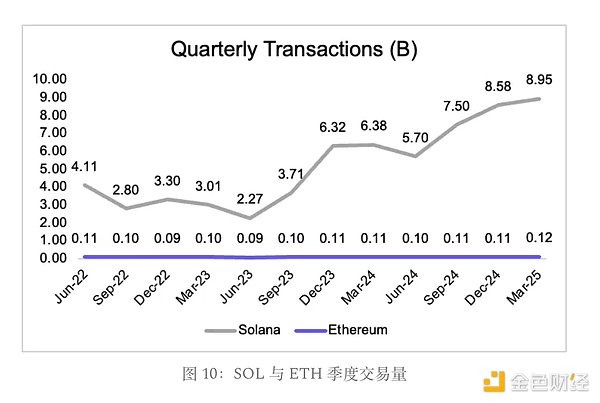
It should be noted that in the financial market, the demand for highly secure assets is much higher than that for assets that only pursue execution speed. This structural preference is good for Ethereum: as more and more high-value assets are put on the chain, the value of Ethereum as a basic settlement layer will continue to increase.
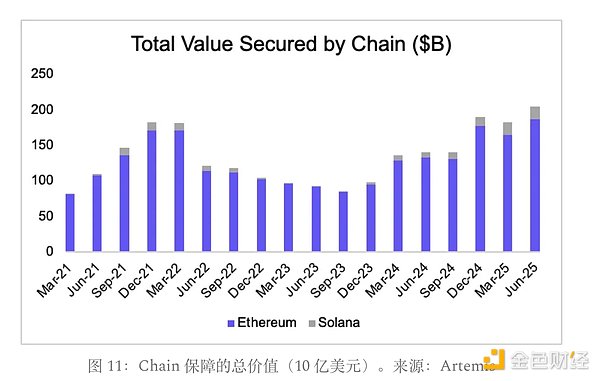
Ethereum's "MicroStrategy Moment": Treasury Trend Boosts ETH
In addition to the two long-term structural drivers of on-chain assets and institutional demand, the rise of Ethereum treasury strategies - similar to MicroStrategy's use of Bitcoin as a corporate asset - may also become a medium-term driver for ETH. The key turning point came at the end of May, when Sharplink Gaming (ticker $SBET) announced its Ethereum treasury strategy, led by Ethereum co-founder Joseph Lubin.
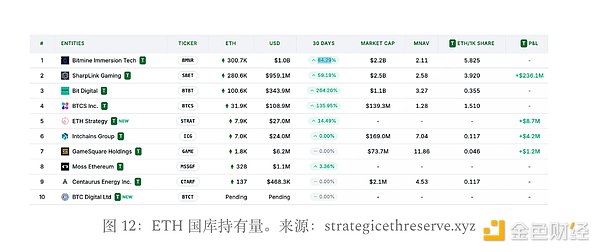
This type of treasury strategy not only helps tokens obtain traditional financial (TradFi) liquidity, but also increases the asset value per share of participating companies. Since the rise of ETH treasury strategies, these treasury companies have accumulated more than 730,000 ETH, and ETH has begun to outperform BTC in this cycle-this is extremely rare in history. We believe that this marks the beginning of the trend of Ethereum treasury strategy adoption.
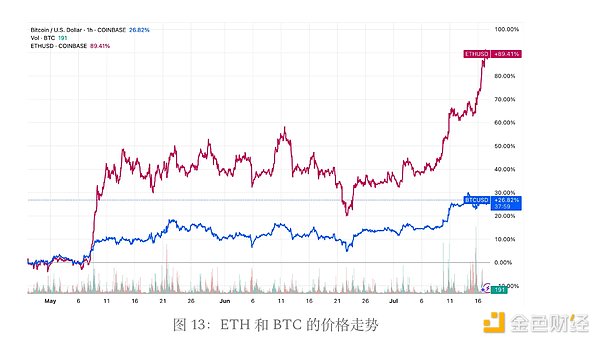
Conclusion: ETH is the reserve asset of the on-chain economy
The development of Ethereum represents a fundamental reshaping of the concept of monetary assets in the digital economy. Just as Bitcoin overcame doubts in its early years and eventually won the title of "digital gold", ETH is also establishing its own unique identity - not by imitating BTC's narrative, but by growing into a more versatile and fundamental asset.
ETH is not just a service certificate like cloud computing, nor is it just a utility token or a source of protocol revenue for paying transaction fees. It is a scarce, programmable, and economically critical reserve asset that supports the security, settlement, and functionality of the increasingly institutionalized on-chain financial system.
 Jasper
Jasper



















